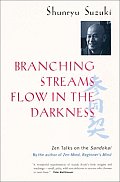Branching Streams Flow in the Darkness
Shunryu Suzuki
University of California Press:
Berkeley, 1999
194 pp. (cloth), $22.50

Since its publication in 1972, Shunryu Suzuki Roshi’s one slim volume, Zen Mind, Beginner’s Mind, has provided the cleanest, simplest—and therefore perhaps, also the straightest—path to Zen. Now, more than a quarter century later, comes its welcome companion volume,Branching Streams Flow in the Darkness: Zen Lectures on the Sandokai. Based on a series of talks Suzuki gave at Tassajara Zen Mountain Center in the summer of 1970, a year and a half before his death, the book is essentially an exegesis, or line-by-line commentary, of a text—in this case a particularly difficult one, the Sandokai, a poem written by the eighth century Zen master Sekito Kisen (Chin. Shitou Xiqian), which today forms an integral part of the Soto Zen liturgy.
The purpose of the Sandokai was to clear up a specious, if inevitable, doctrinal dispute that arose following the death of Eno, the Sixth Patriarch, over which was better, the Northern (gradual enlightenment) or Southern (sudden enlightenment) Schools of Zen. As Suzuki explains:
In China in Sekito’s time, Zen Buddhism was very polemical. In the background of the teaching there was always some controversy. There were many schools of Zen, and they were often lost in dispute. And because they were involved in ideas of right and wrong teaching, or traditional and heretical teaching, they lost the main point of their practice.
And what was that main point? As always when he is articulating the essence of the Buddha’s teaching, Suzuki is at his straightforward best:
If three teachers are pointing at the moon, each has his own finger, and so there are already three schools. But the moon is one.
Doubtless, it was this clear understanding—that the truth of Buddhism was beyond words, beyond disputes, beyond itself even—that has given Suzuki’s teachings their seminal place in American Zen teaching today, despite the few collections of his teachings that have been printed.
Of course, the Sandokai offers more than a correction of an eighth century polemical debate. And one might observe that Sekito himself, like Suzuki, never gets stuck in the problem he is trying to solve. Rather, he takes a high Buddhist view of things, surveying all manner of other dichotomies that have plagued Zen students from Bodhidharma to the present day: between sameness and difference, between nothing and everything, between having faith in your own enlightenment and having to get up at 5 a.m. to cross your legs. All of these Sekito resolves with a single stroke, pointing out that the one and the many are not separate, but one and the many as-the-same, a difficult paradox which Suzuki sums up with his neologism “things-as-it-is,” which is surely one of the great triumphs of Zen over grammar.
For all the difficulty of the Sandokai itself, however, Suzuki’s lectures remain lively and entertaining throughout. The talks here seem less polished than those which comprise the text of Zen Mind, Beginner’s Mind, yet they preserve a great deal more of Suzuki’s humor. For instance, when a student asks him, “Why do we shave our heads?” Suzuki answers, stroking his own bald pate, “So that your thinking mind can go as smoothly as this.”
The book also offers brief, but intimate glimpses into Suzuki’s personal life (he admits that he considers himself a “hen-pecked husband,” but can’t imagine living without his wife) and into his relationships with his students, as shown in the question-and-answer sessions which follow all but three of the book’s fourteen talks. Here Suzuki reveals the fullness of his teaching personality–now consoling, now comical, now telling an already weeping student, “I am not your friend.” In all, I might almost be tempted to say that the Suzuki of Branching Streams is a bit less flat than the more stylized Suzuki I came to know through reading Zen Mind, Beginner’s Mind. But then, since the publication of David Chadwick’s masterful biography Crooked Cucumber, it’s hard to remember the Suzuki I imagined in 1972; he seems so much more real to me today.
Branching Streams Flow in the Darkness is wonderful, simple, and bottomlessly deep, as Suzuki always is. In the upshot, however, I don’t think it will attract the million-plus readers that Zen Mind, Beginner’s Mindhas, as it is more valuable to veteran students of Zen than to beginners.
Thank you for subscribing to Tricycle! As a nonprofit, we depend on readers like you to keep Buddhist teachings and practices widely available.